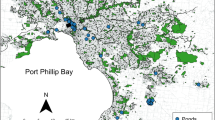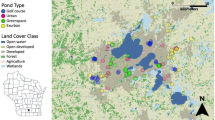Abstract
Variation in the distribution and abundance of species across landscapes has traditionally been attributed to processes operating at fine spatial scales (i.e., environmental conditions at the scale of the sampling unit), but processes that operate across larger spatial scales such as seasonal migration or dispersal are also important. To determine the relative importance of these processes, we evaluated hypothesized relationships between the probability of occupancy in wetlands by two amphibians [wood frogs (Lithobates sylvaticus) and boreal chorus frogs (Pseudacris maculata)] and attributes of the landscape measured at three spatial scales in Rocky Mountain National Park, Colorado. We used cost-based buffers and least-cost distances to derive estimates of landscape attributes that may affect occupancy patterns from the broader spatial scales. The most highly ranked models provide strong support for a positive relationship between occupancy by breeding wood frogs and the amount of streamside habitat adjacent to a wetland. The model selection results for boreal chorus frogs are highly uncertain, though several of the most highly ranked models indicate a positive association between occupancy and the number of neighboring, occupied wetlands. We found little evidence that occupancy of either species was correlated with local-scale attributes measured at the scale of individual wetlands, suggesting that processes operating at broader scales may be more important in influencing occupancy patterns in amphibian populations.



Similar content being viewed by others
References
Alados CL, Pueyo Y, Escos J, Andujar A (2009) Effects of the spatial pattern of disturbance on the patch-occupancy dynamics of juniper-pine open woodland. Ecol Model 220:1544–1550
Baker C, Lawrence R, Montague C, Patten D (2006) Mapping wetlands and riparian areas using Landsat ETM+ imagery and decision-tree-based models. Wetlands 26:465–474
Baldwin RF, Calhoun AJK, deMaynadier PG (2006) Conservation planning for amphibian species with complex habitat requirements: a case study using movements and habitat selection of the wood frog Rana sylvatica. J Herpetol 40:442–453
Berven KA, Grudzien TA (1990) Dispersal in the wood frog (Rana sylvatica): implications for genetic population structure. Evolution 44:2047–2056
Boscolo D, Metzger JP (2011) Isolation determines patterns of species presence in highly fragmented landscapes. Ecography 34:1018–1029
Brouwers NC, Newton AC, Watts K, Bailey S (2010) Evaluation of buffer radius modelling approaches used in forest conservation and planning. Forestry 83:409–421
Burnham KP, Anderson DR (2002) Model selection and inference: a practical information-theoretic approach, 2nd edn. Springer, New York
Corn PS, Jennings ML, Muths E (1997) Survey and assessment of amphibian populations in Rocky Mountain National Park. Northwest Nat 78:34–55
Cunningham JM, Calhoun AJK, Glanz WE (2007) Pond-breeding amphibian species richness and habitat selection in a beaver-modified landscape. J Wildl Manag 71:2517–2526
deMaynadier PG, Hunter ML Jr (1999) Forest canopy closure and juvenile emigration by pool-breeding amphibians in Maine. J Wildl Manag 63:441–450
Dullinger S, Mang T, Dirnböck T, Ertl S, Gattringer A, Grabherr G, Leitner M, Hülber K (2011) Patch configuration affects alpine plant distribution. Ecography 34:576–587
Dunning JB, Danielson BJ, Pulliam HR (1992) Ecological processes that affect populations in complex landscapes. Oikos 65:169–175
Egan RS, Paton PWC (2004) Within-pond parameters affecting oviposition by wood frogs and spotted salamanders. Wetlands 24:1–13
Eggers B, Matern A, Drees C, Eggers J, Härdtle W, Assmann T (2010) Value of semi-open corridors for simultaneously connecting open and wooded habitats: a case study with ground beetles. Conserv Biol 24:256–266
Fortin M-J, Dale M (2005) Spatial analysis: a guide for ecologists. Cambridge University Press, Cambridge
Funk WC, Greene AE, Corn PS, Allendorf FW (2005) High dispersal in a frog species suggests that it is vulnerable to habitat fragmentation. Biol Lett 1:13–16
Goodman D (1987) The demography of chance extinction. In: Soule ME (ed) Viable populations for conservation. Cambridge University Press, New York, pp 11–34
Green DM (2003) The ecology of extinction: population fluctuation and decline in amphibians. Biol Conserv 111:331–343
Hartel T, Nemes S, Cogălniceanu D, Öllerer K, Moga CI, Lesbarrères D, Demeter L (2009) Pond and landscape determinants of Rana dalmatina population sizes in a Romanian rural landscape. Acta Oecol 35:53–59
Hines JE (2006) PRESENCE2—software to estimate patch occupancy and related parameters. USGS-PWRC. http://www.mbr-pwrc.usgs.gov/software/presence.html
Jacquemyn H, Brys R, Hermy M (2002) Patch occupancy, population size and reproductive success of a forest herb (Primula elatior) in a fragmented landscape. Oecologia 130:617–625
Janin A, Léna JP, Ray N, Delacourt C, Allemand P, Joly P (2009) Assessing landscape connectivity with calibrated cost-distance modelling: predicting common toad distribution in a context of spreading agriculture. J Appl Ecol 46:833–841
Johnson M, Johnson LB, Richards C, Beasley V (2002) Predicting the occurrence of amphibians: an assessment of multiple-scale models. In: Scott JM, Heglund PJ, Morrison ML, Haufler JB, Raphael MG, Wall WA, Samson FB (eds) Predicting species occurrences: issues of accuracy and scale. Island Press, Washington, pp 157–170
Joly P, Miaud C, Lehmann A, Grolet O (2001) Habitat matrix effects on pond occupancy in newts. Conserv Biol 15:239–248
Jones JE, Kroll AJ, Giovanini J, Duke SD, Betts MG (2011) Estimating thresholds in occupancy when species detection is imperfect. Ecology 92:2299–2309
Knapp RA, Matthews KR, Preisler HK, Jellison R (2003) Developing probabilistic models to predict amphibian site occupancy in a patchy landscape. Ecol Appl 13:1069–1082
Lamberson RH, McKelvey R, Noon BR, Voss C (1992) A dynamic analysis of northern spotted owl viability in a fragmented forest landscape. Conserv Biol 6:505–512
MacKenzie DI, Bailey LL (2004) Assessing the fit of site-occupancy models. J Agric Biol Environ Stat 9:300–318
MacKenzie DI, Nichols JD, Lachman GB, Droege S, Royle JA, Langtimm CA (2002) Estimating site occupancy rates when detection probabilities are less than one. Ecology 83:2248–2255
Mackenzie DI, Nichols JD, Royle JA, Pollock KH, Bailey LL, Hines JE (2006) Occupancy estimation and modeling: inferring patterns and dynamics of species occurrence. Academic Press, Burlington
Matthews T, Pettus D (1966) Color inheritance in Pseudacris triseriata. Herpetologica 22:269–275
Mazerolle MJ, Desrochers A, Rochefort L (2005) Landscape characteristics influence pond occupancy by frogs after accounting for detectability. Ecol Appl 15:824–834
Muths E, Corn PS, Pessier AP, Green DE (2003) Evidence for disease-related amphibian decline in Colorado. Biol Conserv 110:357–365
O’Brien D, Manseau M, Fall A, Fortin MJ (2006) Testing the importance of spatial configuration of winter habitat for woodland caribou: an application of graph theory. Biol Conserv 130:70–83
Peinetti HR, Kalkhan MA, Coughenour MB (2002) Long-term changes in willow spatial distribution on the elk winter range of Rocky Mountain National Park. Landsc Ecol 17:341–354
Ray N, Lehmann A, Joly P (2002) Modeling spatial distribution of amphibian populations: a GIS approach based on habitat matrix permeability. Biodivers Conserv 11:2143–2165
Regosin JV, Windmiller BS, Reed JM (2003) Terrestrial habitat use and winter densities of the wood frog (Rana sylvatica). J Herpetol 37:390–394
Regosin JV, Windmiller BS, Homan RN, Reed JM (2005) Variation in terrestrial habitat use by four pool-breeding amphibian species. J Wildl Manag 69:1481–1493
Rhodes JR, Callaghan JG, McAlpine CA, de Jong C, Bowen ME, Mitchell DL, Lunney D, Possingham HP (2008) Regional variation in habitat-occupancy thresholds: a warning for conservation planning. J Appl Ecol 45:549–557
Ricklefs RE (1987) Community diversity: relative roles of local and regional processes. Science 235:167–171
Rittenhouse TAG, Semlitsch RD (2007a) Distribution of amphibians in terrestrial habitat surrounding wetlands. Wetlands 27:153–161
Rittenhouse TAG, Semlitsch RD (2007b) Postbreeding habitat use of wood frogs in a Missouri oak-hickory forest. J Herpetol 41:645–653
Rittenhouse TAG, Harper EB, Rehard LR, Semlitsch RD (2008) The role of microhabitats in the desiccation and survival of anurans in recently harvested oak-hickory forest. Copeia 2008:807–814
Rizkalla CE, Swihart RK (2007) Explaining movement decisions of forests rodents in fragmented landscapes. Biol Conserv 140:339–348
Rosenberg DK, Noon BR, Megahan JW, Meslow EC (1998) Compensatory behavior of Ensatina eschscholtzii in biological corridors: a field experiment. Can J Zool 76:117–133
Rothermel BB, Semlitsch RD (2002) An experimental investigation of landscape resistance of forest versus old-field habitats to emigrating juvenile amphibians. Conserv Biol 16:1324–1332
Salas D, Stevens J, Schulz K (2005) Rocky Mountain National Park, Colorado: 2001–2005 vegetation classification and mapping. Technical Memorandum 8260-05-02. U.S. Bureau of Reclamation. Denver
Semlitsch RD (2008) Differentiating migration and dispersal processes for pond-breeding amphibians. J Wildl Manag 72:260–267
Sjögren Gulve P (1994) Distribution and extinction patterns within a northern metapopulation of the pool frog, Rana lessonae. Ecology 75:1357–1367
Smith MA, Green DM (2006) Sex, isolation and fidelity: unbiased long-distance dispersal in a terrestrial amphibian. Ecography 29:649–658
Spencer AW (1964) Movements of boreal chorus frogs. Ph.D. dissertation. Colorado State University, Colorado
Sztatecsny M, Schabetsberger R (2005) Into thin air: vertical migration, body condition, and quality of terrestrial habitats of alpine common toads, Bufo bufo. Can J Zool 83:788–796
Taylor PD, Fahrig L, Henein K, Merriam G (1993) Connectivity is a vital element of landscape structure. Oikos 68:571–573
Taylor PD, Fahrig L, With KA (2006) Landscape connectivity: a return to the basics. In: Crooks KR, Sanjayan M (eds) Connectivity conservation. Cambridge University Press, Cambridge, pp 29–43
Van Buskirk J (2005) Local and landscape influence on amphibian occurrence and abundance. Ecology 86:1936–1947
Vasconcelos D, Calhoun AJK (2004) Movement patterns of adult and juvenile Rana sylvatica (LeConte) and Ambystoma maculatum (Shaw) in three restored seasonal pools in Maine. J Herpetol 38:551–561
Werner EE, Relyea RA, Yurewicz KL, Skelly DK, Davis CJ (2009) Comparative landscape dynamics of two anuran species: climate-driven interaction of local and regional processes. Ecol Monogr 79:503–521
Westbrook CJ, Cooper DJ, Baker BW (2006) Beaver dams and overbank floods influence groundwater-surface water interactions of a Rocky Mountain riparian area. Water Resour Res 42. doi:10.1029/2005WR004560
Zanini F, Klingemann A, Schlaepfer R, Schmidt BR (2008) Landscape effects on anuran pond occupancy in an agricultural countryside: barrier-based buffers predict distributions better than circular buffers. Can J Zool 86:692–699
Zanini F, Pellet J, Schmidt BR (2009) The transferability of distribution models across regions: an amphibian case study. Divers Distrib 15:469–480
Zeigler SL, Neel MC, Oliveira L, Raboy BE, Fagan WF (2011) Conspecific and heterospecific attraction in assessments of functional connectivity. Biodivers Conserv 20:2779–2796
Acknowledgments
We thank Dr. K. Crooks and Dr. P. Doherty for their thoughtful reviews of an earlier version of the manuscript and C. Knopf and D. Bellinghausen for field assistance. The methods in this study were approved by Colorado State University’s Animal Care and Use Committee (permit numbers 05-012A-01). This is contribution no. 388 of the USGS Amphibian Research and Monitoring Initiative (ARMI). Any use of trade, product, or firm names is for descriptive purposes only and does not imply endorsement by the U.S. Government.
Author information
Authors and Affiliations
Corresponding author
Electronic supplementary material
Below is the link to the electronic supplementary material.
Rights and permissions
About this article
Cite this article
Scherer, R.D., Muths, E. & Noon, B.R. The importance of local and landscape-scale processes to the occupancy of wetlands by pond-breeding amphibians. Popul Ecol 54, 487–498 (2012). https://doi.org/10.1007/s10144-012-0324-7
Received:
Accepted:
Published:
Issue Date:
DOI: https://doi.org/10.1007/s10144-012-0324-7




